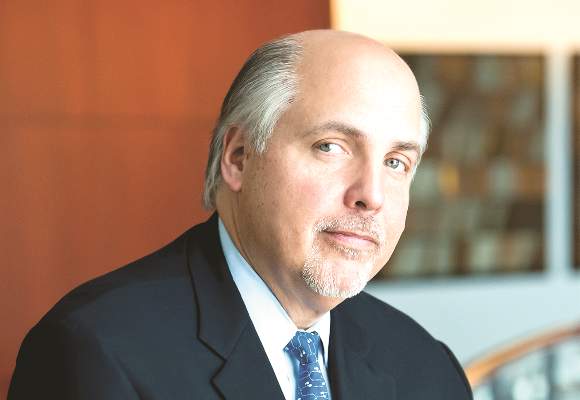User login
Serious pulmonary embolism calls for a rapid, coordinated, and highly multidisciplinary response to prevent fatalities and other severe outcomes, according to Dr. Michael Jaff of Harvard Medical School and Massachusetts General Hospital in Boston. Evolving therapeutic strategies and the “myriad” of physician specialists who help manage cases of serious PE make for a complex array of diagnostic and treatment options for this potentially lethal disorder, he added. On Tuesday morning, Dr. Jaff will moderate a comprehensive, interactive, two-part symposium on the diagnosis and treatment of PE in both adults and children.
Anticoagulation remains the focal point of PE treatment, but many patients with PE develop hypotension, hypoxemia, and serious cardiovascular abnormalities, noted Dr. Jaff. This clinical presentation is known as massive PE and makes the disorder the most common cause of mortality among hospitalized patients. The U.S. Surgeon General has estimated that PE is a contributing factor in as many as 100,000 to 180,000 deaths annually in the United States. Furthermore, the U.S. Centers for Disease Control and Prevention has noted that one in every three PE patients dies within a month of symptom onset, while another third of cases recurs within 10 years.
To help prevent such consequences, “prompt recognition and diagnosis of PE is critical,” Dr. Jaff said. “Getting rapid input from multiple specialties will provide a full review of the available and appropriate therapeutic options, and will facilitate invasive therapy, if needed.”
Serious PE needs the input of physician specialists from the fields of cardiology, interventional cardiology, vascular medicine, vascular surgery, radiology, hematology, pulmonary medicine, and critical care, according to Dr. Jaff. The symposium will feature short presentations and case-based discussions led by these experts, who will update attendees on topics such as PE epidemiology, biomarkers, echocardiographic evaluation, state-of-the-art medical therapy, intravenous thrombolytic therapy, catheter-directed thrombolysis, and percutaneous pharmacomechanical interventions. Other talks will cover strategies for combining percutaneous thrombolysis and thromboaspiration, the use of Vortex strategy for massive PE, and extracorporeal membrane oxygenation and surgical thromboembolectomy in the management of this disorder.
Although these novel approaches can improve patient outcomes, few clinical trials have compared the various PE treatment modalities, Dr. Jaff noted. For example, the literature lacks trials comparing standard anticoagulation and full- and half-dose catheter-directed thrombolytic therapy; standard anticoagulation and percutaneous mechanical thrombectomy with thrombolytics; pharmacomechanical thrombolysis with and without extracorporeal membrane oxygenation; and pharmacomechanical and surgical pulmonary embolectomy, Dr. Jaff said. Other future trials should explore the role of inferior vena cava filters in PE patients who are receiving lytics or pharmacomechanical thrombolysis, and should evaluate the optimal timing and dose of anticoagulants administered during and after interventions, he said.
The relative shortage of rigorous trial data heightens the importance of physician expertise and institutional resources for managing PE, according to several thought leaders. To help enhance outcomes and coordinate clinical resources, Massachusetts General Hospital and other institutions have created pulmonary embolism response teams (PERTs) made up of an array of medical and surgical specialists who have deep experience in evaluating and treating moderate-risk and high-risk PE patients.
Tuesday’s symposium will end with a discussion of the emergence of national PERT centers and the advantages of the team approach to PE management. “This session will provide insights into all aspects of PE management. I think the entire session is worth highlighting!” said Dr. Jaff.
Sessions 17 & 18: Management of Pulmonary Embolism: The Momentum for Effective Treatment is Real (Parts 1 and 2)
Tuesday, 7:00 a.m. – 12:00 p.m.
Trianon Ballroom, 3rd Floor
Serious pulmonary embolism calls for a rapid, coordinated, and highly multidisciplinary response to prevent fatalities and other severe outcomes, according to Dr. Michael Jaff of Harvard Medical School and Massachusetts General Hospital in Boston. Evolving therapeutic strategies and the “myriad” of physician specialists who help manage cases of serious PE make for a complex array of diagnostic and treatment options for this potentially lethal disorder, he added. On Tuesday morning, Dr. Jaff will moderate a comprehensive, interactive, two-part symposium on the diagnosis and treatment of PE in both adults and children.
Anticoagulation remains the focal point of PE treatment, but many patients with PE develop hypotension, hypoxemia, and serious cardiovascular abnormalities, noted Dr. Jaff. This clinical presentation is known as massive PE and makes the disorder the most common cause of mortality among hospitalized patients. The U.S. Surgeon General has estimated that PE is a contributing factor in as many as 100,000 to 180,000 deaths annually in the United States. Furthermore, the U.S. Centers for Disease Control and Prevention has noted that one in every three PE patients dies within a month of symptom onset, while another third of cases recurs within 10 years.
To help prevent such consequences, “prompt recognition and diagnosis of PE is critical,” Dr. Jaff said. “Getting rapid input from multiple specialties will provide a full review of the available and appropriate therapeutic options, and will facilitate invasive therapy, if needed.”
Serious PE needs the input of physician specialists from the fields of cardiology, interventional cardiology, vascular medicine, vascular surgery, radiology, hematology, pulmonary medicine, and critical care, according to Dr. Jaff. The symposium will feature short presentations and case-based discussions led by these experts, who will update attendees on topics such as PE epidemiology, biomarkers, echocardiographic evaluation, state-of-the-art medical therapy, intravenous thrombolytic therapy, catheter-directed thrombolysis, and percutaneous pharmacomechanical interventions. Other talks will cover strategies for combining percutaneous thrombolysis and thromboaspiration, the use of Vortex strategy for massive PE, and extracorporeal membrane oxygenation and surgical thromboembolectomy in the management of this disorder.
Although these novel approaches can improve patient outcomes, few clinical trials have compared the various PE treatment modalities, Dr. Jaff noted. For example, the literature lacks trials comparing standard anticoagulation and full- and half-dose catheter-directed thrombolytic therapy; standard anticoagulation and percutaneous mechanical thrombectomy with thrombolytics; pharmacomechanical thrombolysis with and without extracorporeal membrane oxygenation; and pharmacomechanical and surgical pulmonary embolectomy, Dr. Jaff said. Other future trials should explore the role of inferior vena cava filters in PE patients who are receiving lytics or pharmacomechanical thrombolysis, and should evaluate the optimal timing and dose of anticoagulants administered during and after interventions, he said.
The relative shortage of rigorous trial data heightens the importance of physician expertise and institutional resources for managing PE, according to several thought leaders. To help enhance outcomes and coordinate clinical resources, Massachusetts General Hospital and other institutions have created pulmonary embolism response teams (PERTs) made up of an array of medical and surgical specialists who have deep experience in evaluating and treating moderate-risk and high-risk PE patients.
Tuesday’s symposium will end with a discussion of the emergence of national PERT centers and the advantages of the team approach to PE management. “This session will provide insights into all aspects of PE management. I think the entire session is worth highlighting!” said Dr. Jaff.
Sessions 17 & 18: Management of Pulmonary Embolism: The Momentum for Effective Treatment is Real (Parts 1 and 2)
Tuesday, 7:00 a.m. – 12:00 p.m.
Trianon Ballroom, 3rd Floor
Serious pulmonary embolism calls for a rapid, coordinated, and highly multidisciplinary response to prevent fatalities and other severe outcomes, according to Dr. Michael Jaff of Harvard Medical School and Massachusetts General Hospital in Boston. Evolving therapeutic strategies and the “myriad” of physician specialists who help manage cases of serious PE make for a complex array of diagnostic and treatment options for this potentially lethal disorder, he added. On Tuesday morning, Dr. Jaff will moderate a comprehensive, interactive, two-part symposium on the diagnosis and treatment of PE in both adults and children.
Anticoagulation remains the focal point of PE treatment, but many patients with PE develop hypotension, hypoxemia, and serious cardiovascular abnormalities, noted Dr. Jaff. This clinical presentation is known as massive PE and makes the disorder the most common cause of mortality among hospitalized patients. The U.S. Surgeon General has estimated that PE is a contributing factor in as many as 100,000 to 180,000 deaths annually in the United States. Furthermore, the U.S. Centers for Disease Control and Prevention has noted that one in every three PE patients dies within a month of symptom onset, while another third of cases recurs within 10 years.
To help prevent such consequences, “prompt recognition and diagnosis of PE is critical,” Dr. Jaff said. “Getting rapid input from multiple specialties will provide a full review of the available and appropriate therapeutic options, and will facilitate invasive therapy, if needed.”
Serious PE needs the input of physician specialists from the fields of cardiology, interventional cardiology, vascular medicine, vascular surgery, radiology, hematology, pulmonary medicine, and critical care, according to Dr. Jaff. The symposium will feature short presentations and case-based discussions led by these experts, who will update attendees on topics such as PE epidemiology, biomarkers, echocardiographic evaluation, state-of-the-art medical therapy, intravenous thrombolytic therapy, catheter-directed thrombolysis, and percutaneous pharmacomechanical interventions. Other talks will cover strategies for combining percutaneous thrombolysis and thromboaspiration, the use of Vortex strategy for massive PE, and extracorporeal membrane oxygenation and surgical thromboembolectomy in the management of this disorder.
Although these novel approaches can improve patient outcomes, few clinical trials have compared the various PE treatment modalities, Dr. Jaff noted. For example, the literature lacks trials comparing standard anticoagulation and full- and half-dose catheter-directed thrombolytic therapy; standard anticoagulation and percutaneous mechanical thrombectomy with thrombolytics; pharmacomechanical thrombolysis with and without extracorporeal membrane oxygenation; and pharmacomechanical and surgical pulmonary embolectomy, Dr. Jaff said. Other future trials should explore the role of inferior vena cava filters in PE patients who are receiving lytics or pharmacomechanical thrombolysis, and should evaluate the optimal timing and dose of anticoagulants administered during and after interventions, he said.
The relative shortage of rigorous trial data heightens the importance of physician expertise and institutional resources for managing PE, according to several thought leaders. To help enhance outcomes and coordinate clinical resources, Massachusetts General Hospital and other institutions have created pulmonary embolism response teams (PERTs) made up of an array of medical and surgical specialists who have deep experience in evaluating and treating moderate-risk and high-risk PE patients.
Tuesday’s symposium will end with a discussion of the emergence of national PERT centers and the advantages of the team approach to PE management. “This session will provide insights into all aspects of PE management. I think the entire session is worth highlighting!” said Dr. Jaff.
Sessions 17 & 18: Management of Pulmonary Embolism: The Momentum for Effective Treatment is Real (Parts 1 and 2)
Tuesday, 7:00 a.m. – 12:00 p.m.
Trianon Ballroom, 3rd Floor

